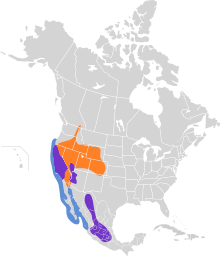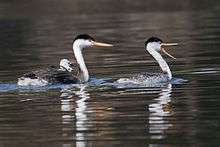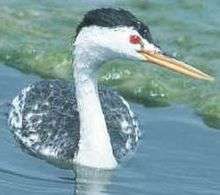Clark's grebe
| Clark's grebe | |
|---|---|
 | |
| Nonbreeding plumage | |
| Scientific classification | |
| Kingdom: | Animalia |
| Phylum: | Chordata |
| Class: | Aves |
| Order: | Podicipediformes |
| Family: | Podicipedidae |
| Genus: | Aechmophorus |
| Species: | A. clarkii |
| Binomial name | |
| Aechmophorus clarkii (Lawrence, 1858) | |
 | |
Clark's grebe (Aechmophorus clarkii) is a North American waterbird species in the grebe family.[2] Until the 1980s, it was thought to be a pale morph of the western grebe, which it resembles in size, range, and behavior. Intermediates between the two species are known.
The "Clark" of its common name—and its specific epithet clarkii—honors John Henry Clark, a 19th-century American surveyor who was also a naturalist and collector.[3] The genus name Aechmophorus comes from the Ancient Greek words "aichme", meaning spear, and "phoros", meaning someone who bears things around; it refers to the bird's long, dagger-like beak.
This species nests on large inland lakes in western North America and migrates to the Pacific coast over the winter. It maintains local populations year-round in California, Nevada, and Arizona (the Lower Colorado River Valley), as well as in central Mexico. It feeds by diving for carp, herring, mollusks, crabs, and salamanders.
It performs the same elaborate courtship display as the western grebe.
Description

Clark's grebe closely resembles the western grebe, but with an overall paler plumage on its back, as well as a larger portion of its face covered in white, as it extends above the eyes, rather than just below them. It is also slightly smaller than the western species. The grebe has a long, slender neck and the species ranges in size from 22–29 inches (56–74 cm), with a wingspan of 24 inches (61 cm). Among its distinguishing features is its bill, which is slightly upturned and bright yellow, whereas the Western Grebe's bill is straight and greenish-yellow.
There are few changes between the sexes, the most notable feature that distinguishes males from females is the presence of a slight crest on the heads of males. In juveniles, the plumage is again similar to the Western Grebe, however it is also paler compared to the greyer Western species.[4]
Taxonomy
The Clark's grebe (Aechmophorus clarkii) is a waterbird of the order Podicipediformes and family Podicipedidae, and are closely related to loons (Gaviidae), another family of waterbirds.
Related species
Commonly mistaken for the slightly larger western grebe, the Clark's grebe was long thought to simply be a "white morph" (a version with paler colours and more white) of the species. It was not until the genes of the two species were more closely identified in the 1980s when it was discovered that the differences between the two "versions" was similar to the genetic difference between closely related species, as opposed to simply a phenotypic (physical) variation.[5]
Subspecies
There are two subspecies of Clark's grebe:
- A. c. clarkii, (Lawrence, 1858), north & central Mexico
- A. c. transitionalis, (Dickerman, 1986), western Canada & western United States
Habitat and distribution
Clark's grebes occur seasonally throughout the majority of Western America, with a distribution ranging as far south as Mexico, and reaching as far north as British Columbia and Saskatchewan. They prefer warm climates, and being waterbirds, they require bodies of water that offer the necessary food and shelter that they need to thrive—usually lakes or suitable wetlands—that are also in proximity to suitable tree cover that they can use for nesting.[6]
Breeding is done across a large portion of North America, spanning from British Columbia to Texas, and the grebes tend to favour larger bodies of water for this, as they congregate in large flocks. When it is time for the birds to winter, they head further into Central America, as well as further south towards Mexico and some regions of California.[7]
Behaviour
Vocalizations
The calls of the Clark's grebe is similar to its western counterpart, however it is a single, extended kreeeed as opposed to the traditional two-note kreed-kreet of the western grebe. Furthermore, the calls of the grebe tend to vary very little between sexes.
Diet
Thought to be a fish specialist as a result of the examination of their pellets and stomach contents, it has been shown that the Clark's grebe is actually an opportunist when it comes to the food it eats, and is less picky with its selection than previously imagined. This means that the species will actually consume a wide variety of things such as salamanders, crustaceans, polychaete worms and insects while diving and foraging for their preferred small fish, so long as they fit the size constraints of the bill.[8]
Reproduction
Clark grebes behave in a monogamy, in that there are unpaired males that far outnumber the females. Males, while they stay with their mate until at least a few weeks after the hatching of their young, will have several sexual partners in their life time. It is less known if pairs will eventually mate again in the future. There are two courtship ceremonies that are performed before selection and mating take place: the "rushing ceremony" and the "weed ceremony". They entail a sequence of performances and advertisements/dances with the partner, or presenting the partner with a bundle of weeds and performing a different set of dances, respectively. As there are fewer females than males, the final decision of whether or not mating occurs depends on the females. Therefore, there is a level of sexual selection within the species.[9] These courtships take place during spring migration and shortly after arriving on the breeding grounds.
It is important to note that while there are very few cases of breeding between clark's and western grebes, there have been cases where phenotypic hybrids (birds with plumage that is similar to both species) have mated and produced fertile offspring. It is believed, however, that this becomes less likely when the individuals are from different migrations and are not hybrids, as they have a greater chance of failing during the courtships.
Gallery
 Breeding plumage
Breeding plumage On nest
On nest
References
- ↑ BirdLife International (2012). "Aechmophorus clarkii". IUCN Red List of Threatened Species. Version 2013.2. International Union for Conservation of Nature. Retrieved 26 November 2013.
- ↑ "Clark's Grebe". Birds of North America. Cornell Lab of Ornothology. Retrieved 7 April 2017.
- ↑ Beolens, Bo; Michael Watkins (2003). Whose Bird?. Christopher Helm. p. 84. ISBN 0-7136-6647-1.
- ↑ Storer, Robert W. and Gary L. Nuechterlein. 1992. Clark's Grebe (Aechmophorus clarkii), version 2.0. In The Birds of North America (P. G. Rodewald, editor). Cornell Lab of Ornithology, Ithaca, New York, USA. https://doi.org/10.2173/bna.26b
- ↑ Storer, Robert W. and Gary L. Nuechterlein. 1992. Clark's Grebe (Aechmophorus clarkii), version 2.0. In The Birds of North America (P. G. Rodewald, editor). Cornell Lab of Ornithology, Ithaca, New York, USA. https://doi.org/10.2173/bna.26b
- ↑ Storer, Robert W. and Gary L. Nuechterlein. 1992. Clark's Grebe (Aechmophorus clarkii), version 2.0. In The Birds of North America (P. G. Rodewald, editor). Cornell Lab of Ornithology, Ithaca, New York, USA. https://doi.org/10.2173/bna.26b
- ↑ Storer, Robert W. and Gary L. Nuechterlein. 1992. Clark's Grebe (Aechmophorus clarkii), version 2.0. In The Birds of North America (P. G. Rodewald, editor). Cornell Lab of Ornithology, Ithaca, New York, USA. https://doi.org/10.2173/bna.26b
- ↑ Palmer, R. S. 1962a. Handbook of North American Birds, Vol. 1: Loons through Flamingos. New Haven: Yale Univ. Press.
- ↑ Nuechterlein, G. L. and R. W. Storer. 1982. The pair formation displays of the Western Grebe. Condor no. 84:351-369.
Ratti, J.T., 1979. Reproductive separation and isolating mechanisms between dark- and light-phased grebes. Auk 96:573-586.
External links
- Clark's Grebe videos on the Internet Bird Collection
- Clark's Grebe photo gallery VIREO
- "Aechmophorus clarkii". Integrated Taxonomic Information System. Retrieved 24 February 2009.
